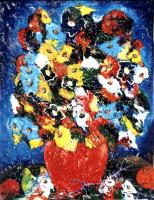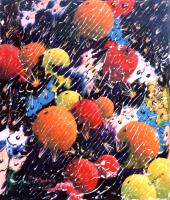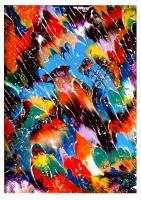 |
|
|
(Versión inglesa solamente)
Charles Carson subliminal techniques.
By Jacques de Roussan
historian, Art writer.
Half way between the figurative and the abstract, Charles Carson takes the viewer on an expressionistic adventure where movement, form, colour and even the drawing make an absolutely unbreakable whole. In this way, vibrations become optical leads that effortlessly intensify the whole, and underline those stronger elements that seem to be in opposition to each other or even juxtapose one another within the composition.
The result is a vision in which the imagery seems to be coming out of an iridescent universe, while at the same time forming a link between the conscious and subconscious, in a way that allows us access to movement that is linked to these two planes of being. Beginning with this visualization, the artist is able to present these scenes and subjects, the composition and unfolding of which are at the limit of a purely graphic transposition, thus presenting us with a rich visual perception.
|
|
In truth, the artist is not looking to revolutionize the art of painting but rather to adopt a truly personal interpretative manner, which sometimes shows up as development that is perhaps fast-paced, yet which leads to solutions involving continuity. A way of thinking that within the visual arts world, precedes and follows all major careers meaning, in other words, a wholly creative life....”
Carson has done very well to forget the lessons of his elders and not fall into the trap of mere repetition. This is what allows him to continue to work within the themes that are characteristic of the art of painting, while at the same time shaking them up through new interpretations: landscapes, scenes, still lifes, nature subjects, etc...
This goes a long way to proving just how well he is able to act as an intermediary between the imaginary and reality, as he looks through the prism of a relativist vision at his subjects and their interpretation.
|
 |
|
|
So, by means of forms and colours, the artist interprets and transposes with great vigour and yet subtlety. The viewer must learn to READ – whether or not there is any consciousness of the scenes or subjects being offered. In a manner that is somehow almost disturbing, Carson manages to link the elements of the composition so that we can distinguish the statement he is making, lying behind the evident strength of his imagination. Everything is then subject to a deeper reading, which is sometimes even esoteric in its expressiveness. Behind the richness of this act of creation are set out different planes in which the subjects and the settings of the painting are literally and pictorially intertwined.
This means that everything becomes as a silhouette, merely suggested, and we can read if not interpret it by calling upon a minimum of pictorial references. This does not mean that this type of reading is compulsory at the first viewing, but rather that it stems from an optical phenomenon with, as its background, a sort of chromatic kaleidoscope which becomes like a veritable feast for the eyes of the viewer.
We are talking about a form of pictorial sublimation in which we may discover an in-between world in constant and perpetual movement.
|

|
|
|
To give greater emphasis to the bi-dimensional character of his paintings and to “oblige” the vision to penetrate more deeply into the core of the subject, Carson paints “with the knife” with the express intention of adding depth to his interpretation. Thanks to this technique, he is able to imprint an extra degree of personality, which complements composition, according to a particular angle (using the diagonal) which underlines very precisely those vibrations already visible in the composition.
The fact that this movement nevertheless allows both the borders and any areas of blank colour to exist adds a further mysterious and expressionistic quality and reinforces the presence of other elements of the composition.
It is interesting to note that in paintings by this artist, the forms, with their undeniably chromatic character, “dance” a sort of elegant ballet, described in a series of arabesques and pas-de-deux that may be an ultimate statement from Carson himself. It is not just a mad jumble: there is a very precise ordering as in ballet, with a fleeting rhythm perhaps, but one that impresses itself on the viewer’s eye. And it is in this manner of interpretation that the artist is likely to find inspiration for his pictorial development over the long term.
|
|
|